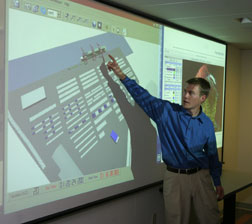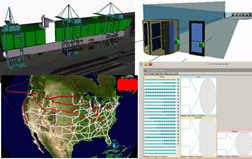NEWS RELEASES
FOR IMMEDIATE RELEASE
January 11, 2006
Sandia researchers aim to keep points-of-entry safe through systems-level modeling of operations
 Sandia researcher Andy Vaughn shows an example of how simulations developed at Sandia can help evaluate new sensor technologies and suggest ways to minimize impacts by determining the most optimum technologies and configurations. In this case, cargo inspection equipment at a seaport increases the probability of detecting illicit materials but also disrupts operations and causes large delays when used in certain configurations.
Sandia researcher Andy Vaughn shows an example of how simulations developed at Sandia can help evaluate new sensor technologies and suggest ways to minimize impacts by determining the most optimum technologies and configurations. In this case, cargo inspection equipment at a seaport increases the probability of detecting illicit materials but also disrupts operations and causes large delays when used in certain configurations.
Download 300dpi JPEG image, “andy-vaughn.jpg,” 466K (Media are welcome to download/publish this image with related news stories.)
LIVERMORE, Calif. — Carolyn Pura, who serves as the program deputy for borders and transportation security in Sandia National Laboratories’ homeland security business unit, is blunt in assessing the nature of her job. “Protecting our borders is difficult and expensive,” she says.
Almost as quickly, however, she asserts that Sandia’s recent work on border security is well on its way to providing an enormously valuable national asset by providing federal agencies with a reliable and comprehensive simulation capability that lets officials “test drive” various security solutions prior to investing in them.
The focus of the Borders Grand Challenge, funded by a three-year, $6 million laboratory-directed research and development (LDRD) project, was to develop simulation-based systems analyses characterizing the security of the U.S. Border System and the impact of new detection technologies and concepts of operation. The work capitalizes on a range of existing Sandia capabilities, including the Weapons of Mass Destruction Decision Analysis Center (WMD-DAC), the National Infrastructure Simulation and Analysis Center (NISAC, a joint Sandia and Los Alamos National Laboratory program), and even the lab’s expertise in robotics. Some 21 Sandia researchers from both its California and New Mexico sites worked on the project with Pura serving as principal investigator and Dan Horschel as project manager.
Models examine flow of people and goods
The interactive analysis that serves as the hallmark of
the program has largely focused on the illegal smuggling
of radiological/nuclear material but can also be applied
to other threats such as explosives or chemical/biological
agent attack. The work uses detailed models that capture
actual facilities and procedures and examines border operations
of all kinds. Of utmost concern is the flow of people and
goods through the various border choke points.
“There is a cost-benefit tradeoff associated with any technology that might be used in border security,” Horschel explains. With commerce, for example, officials must consider the flow of people and goods crossing the border, any delays that may occur due to security provisions, and the operational costs that emerge as a consequence of the flow and delay. Sandia’s unique systems-level methodologies and tools address these complexities and allow homeland security officials to make data-driven decisions.
Economic impact is key
Sandian Mark Ehlen served as the lead for economic modeling.
Ehlen points out that a unique feature of the program is
its ability to project the economic impact that might be
felt if a venue implements certain security options. A typical
port whose processing time increases due to a newly configured
set of chemical detectors, for example, might expect to
increase its on-site inventories and shipments by up to
15 percent, leading to increased business costs and decreased
sales figures. In addition, said Ehlen, the firms that ship
through the port will be affected by the delays and increased
costs and may take their business elsewhere. Such consequences
will fluctuate from venue to venue, of course, depending
on the security measures and the venue’s own operational
plan.
Sandia’s models, by simulating the effects of detector placement, the use of facial recognition software, or the impact of other technology devices and strategies, can give decision-makers specific and reliable data to help make sound decisions about how and where to invest.
 Analysis tools developed by Sandia can help evaluate
the impact of technologies at border crossings in terms
of throughput, security, and economic cost.
Analysis tools developed by Sandia can help evaluate
the impact of technologies at border crossings in terms
of throughput, security, and economic cost. Download 300dpi JPEG image, “borders-highlight.jpg,” 151K (Media are welcome to download/publish this image with related news stories.)
Mid-fidelity vs. High-fidelity modeling
The models themselves come in two primary forms.
“Mid-fidelity” models offer a broader, bigger-picture look at a border location that might give users the ability, for example, to view personally owned vehicle and cargo vehicle flows at an actual facility, using that facility’s own procedures. A “higher-fidelity” model, seen on the computer screen when the operator “zooms in” on the activity, might focus on security interrogation and feature detailed sensor modeling. High-fidelity models, because of their visualization features and accurate geometries and motion, provide a sound environment for training and can be quickly reconfigured to address border concepts-of-operation.
Sandia’s models have been integrated to include multiple domains, including air, sea, and land. All of the domains have been built with the capability of analyzing the impacts of different types of sensing equipment, from radiation detection to x-ray equipment. Both a land crossing pedestrian model and an airport, for example, examine the movements of people and look at biometrics technology, while a seaport and land cargo port analyze cargo inspection equipment.
“Hot Source” dilemma
One significant issue that security officials are known
to face is the problem of “hot sources.” These
occur when multiple detectors sound alarms simultaneously
due to benign radiation sources. Hot sources significantly
disrupt port operations by causing large delays while the
source is sorted out and determined to be non-threatening.
Sandia’s modeling work helps users of the system address the hot source problem by examining various detection scenarios and options to consider. An “in-situ” option, whereby traffic is stopped while threat sources are localized with a portable detector and removed from the primary traffic stream, might be suitable for certain venues, while others might choose to maintain a “self-identification pre-sort” lane of traffic that allows medical patients or known radioactive shipments to sort themselves out of traffic. Sandia-developed simulations help officials identify the best “encounter geometry” within their facilities and the most “throughput-friendly” detector locations.
Though Pura and Horschel say the work represents the most comprehensive modeling work available on border security, the research has the potential to go much further. Ideally, Sandia could extend the capability to all ports of entry across the country, creating a complete national model that is able to examine changing security measures and operations and their impact. “What we have now are high-quality, targeted studies,” says Horschel. “The value a national model could offer decision-makers at the highest level could be immeasurable.”
Sandia is a multiprogram laboratory operated by Sandia Corporation, a Lockheed Martin company, for the U.S. Department of Energy’s National Nuclear Security Administration. Sandia has major R&D responsibilities in national security, energy and environmental technologies, and economic competitiveness.
Sandia media contact: Mike Janes, mejanes@sandia.gov, (925) 294-2447